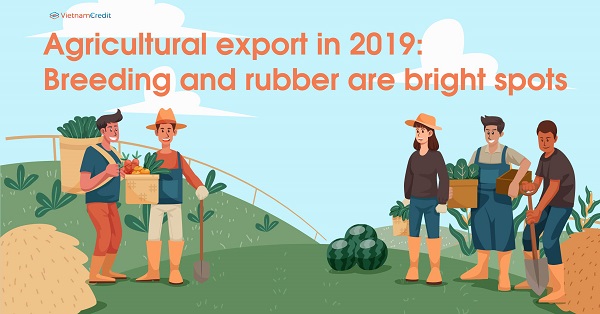Over the past three decades, coffee has played an important role in Vietnam’s agriculture and economy. The coffee industry has created more than half a million jobs, and is the main livelihood of thousands of households. Coffee export value usually accounts for about 15% of total agricultural export turnover and the share of coffee has always exceeded 10% of agricultural GDP in recent years.
Development history of Vietnam's coffee industry
Coffee was first introduced to Vietnam by the French in 1857. Thanks to the government support, Vietnam's coffee production increased from 5900 hectares in the early 1990s to half a million hectares with an annual output of more than 25 million bags in 2010, which makes Vietnam the second largest coffee manufacturer in the world.
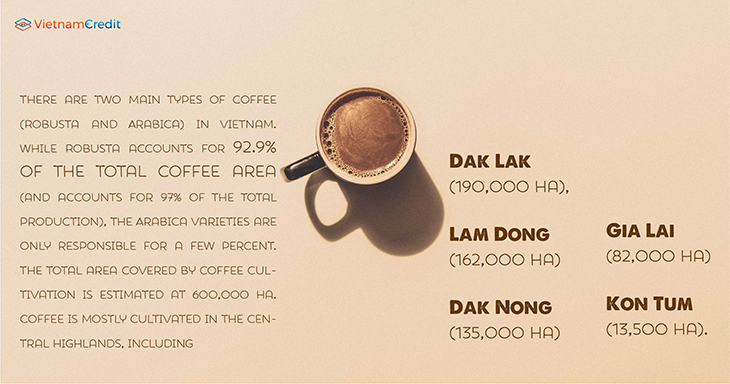
There are two main types of coffee (Robusta and Arabica) in Vietnam. While Robusta accounts for 92.9% of the total coffee area (and accounts for 97% of the total production), the Arabica varieties are only responsible for a few percent. The total area covered by coffee cultivation is estimated at 600,000 ha. Coffee is mostly cultivated in the Central Highlands, including Dak Lak (190,000 ha), Lam Dong (162,000 ha), Dak Nong (135,000 ha), Gia Lai (82,000 ha) and Kon Tum (13,500 ha).
Zoning and cultivation
Vietnamese coffee is grown in areas with altitudes of 500 to 1,200 meters above sea level, so the coffee flavor has a sweet smell. This was recognized at the first International Coffee Roasting Competition held in Paris in 2015 by the Agro-product Stabilization Agency and the Agricultural Product Value Added Association. In this competition, a Vietnamese coffee company was awarded a Silver Medal for AROMA coffee product (a blend of the three best Arabica coffees in Vietnam) and a Bronze Medal for intensive coffee (a blend of Arabica Bourbon from Cau Dat - Da Lat and Robusta from Buon Ma Thuot).
With the aim of limiting the expansion of mass farming whilst increasing the quality and revenue from coffee production, the Government has outlined a master plan to review and re-zone coffee regions, and replace old coffee trees with new varieties. Accordingly, Robusta will be grown in four provinces in the Central Highlands: Dak Lak, Lam Dong, Dak Nong and Gia Lai with a total area of 530,000 hectares. Arabica coffee will be planted in Son La (Northwest), Nghe An, Quang Tri (Central), Lam Dong (Central Highlands) and some other areas in the central region.
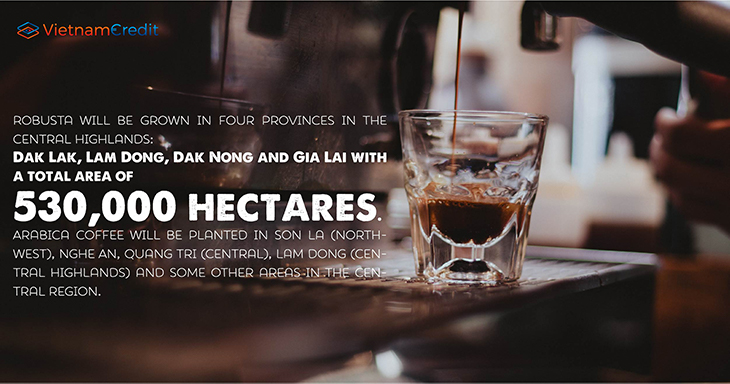
Production system
Regarding coffee cultivation, there are specialized farms and hybrid farms. In particular, there exist two main types of hybrid farm. The first are farms where different crops are grown on the same block. This is called a synchronous farming system. In other words, coffee tree will be grown with other crops. The second type is where different crops are grown in separate plots. This is called a separate farming system.
Traditional coffee harvesting by stripping both green and ripe pods (Central Highlands region) is recognized as one of the reasons for the poor quality of Vietnamese coffee.
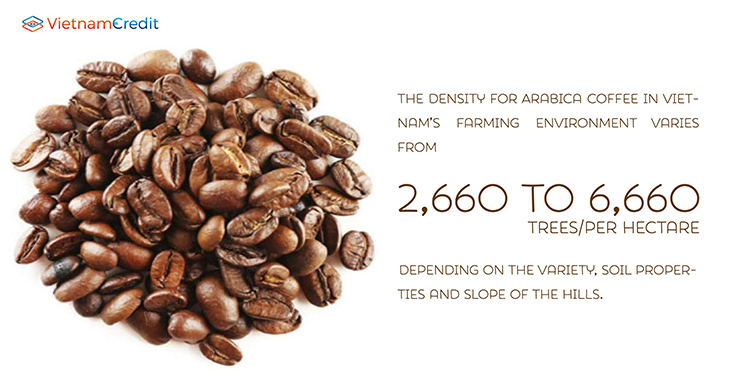
The density for Arabica coffee in Vietnam’s farming environment varies from 2,660 to 6,660 trees per hectare, depending on the variety, soil properties and slope of the hills. For Robusta coffee, the density is about 1,330 trees per hectare. Cultivation usually starts in the rainy season. It is necessary to provide adequate water and ensure sun protection and wind shading for coffee trees.
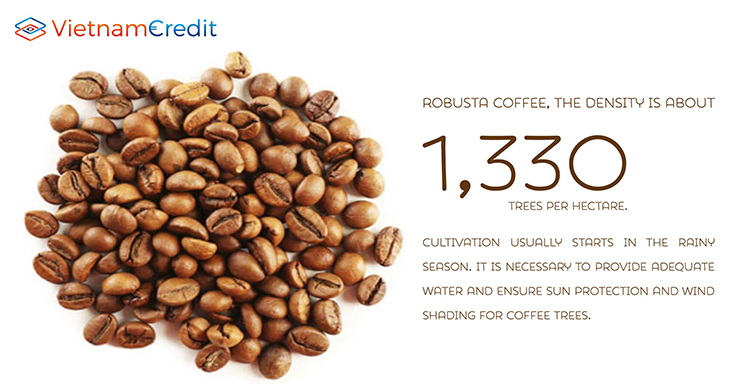
In addition to the expansion of cultivated areas, many Vietnamese coffee farmers have been applying advanced agricultural production technology to achieve certificates such as 4C (Common Code for the Coffee Community), VietGAP (Good Agricultural Practice of Vietnam), UTZ (Certified Certified), and RFA (Rainforest Alliance). As of the end of 2017, over 200,000 hectares, accounting for more than 30% of Vietnam's total coffee growing acreage, had been certified as sustainability initiatives.
Challenges and difficulties for Vietnam's coffee industry
Over the past decades, Vietnamese coffee production has developed as an export-oriented industry. Despite being the world's second largest coffee manufacturer and exporter, Vietnamese coffee industry is currently facing a lot of challenges:
· Climate change with extreme weather conditions has put coffee growing areas in danger. According to the International Center for Tropical Agriculture (CIAT), rising temperatures and changing rainfall may cost Vietnam 50% of its current Robusta production area by 2050.
· About 50% of the total coffee trees planted in Vietnam are from 10 to 15 years old, which offers the highest yield. In the coming years, Vietnamese coffee production will mainly rely on these trees. Nearly 30% of other coffee trees are between 15 and 20 years old, and about 20% over 20 years old, which means productivity cannot be guaranteed.
· The area of newly planted coffee trees has increased significantly in recent years, but most are located in unsuitable areas with shallow, steep slopes, and lack of irrigation water. Therefore, although newly planted acreage has increased, achieving high economic efficiency is difficult due to low productivity and high production costs.
· Intensive farming practices used in the past required too much input (fertilizer, irrigation, etc.) to achieve maximum yields. This not only causes the depletion of coffee trees but also results in seriously contaminated soil, leading to many diseases and pests, especially fungi and root nematodes.
· The small scale and fragmentation household production have caused an unstable and low-quality production. The differentiation of investment, harvesting, and processing among manufacturers has affected the quality of Vietnam’s coffee industry.
· Although coffee is a water-intensive crop, old-fashioned but outdated irrigation is still the main method used in most coffee growing regions, causing severe water loss.
Prospects and planning
To cope with these challenges, Vietnamese policymakers have introduced long-term reforms of the coffee industry. In 2014, the Government outlined a sustainable coffee development plan to 2020 with a vision to 2030, which is aimed at the sustainable management of economic and environmental resources for the coffee industry.
The plan includes specific economic targets for the sector's performance, such as increasing deep processing for higher value added. It also sets specific environmental goals, including a nationwide limit of coffee cultivation at 600,000 hectares, replacing old low-yielding coffee trees with new, more productive and capable varieties.
It can be said that Vietnam's coffee industry has been forced to look to the future to solve environmental and economic gaps. These goals show a desire to maintain Vietnam’s position as a coffee “giant”, ensuring stable production conditions for the future.
Source: Country Coffee Profile Vietnam – 2019, Primecoffea
https://primecoffea.com/nganh-ca-phe-viet-nam-hanh-trinh-ba-thap-ky.html






